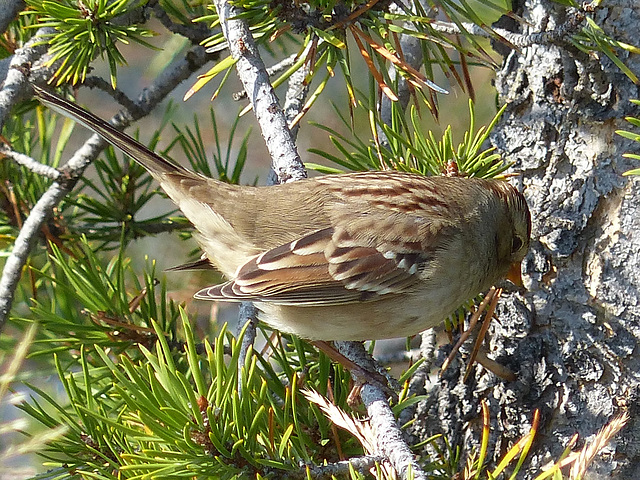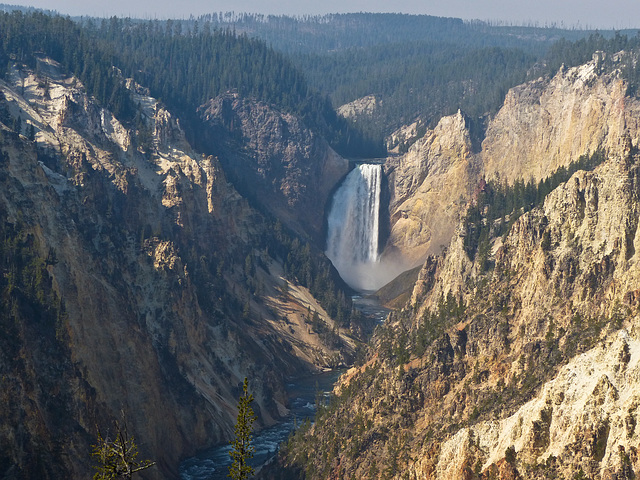
Yellowstone National Park & Grand Tetons
Grand Prismatic Spring, Yellowstone National Park, Wyoming
Another view taken at Grand Prismatic Spring. This is such an amazing hot spring, photographed on 13 September 2012, during my recent week's trip with friends down to Yellowstone National Park and Grand Teton National Park. This photo was taken from the boardwalk, but there is also a hill you can climb to get a higher view over the whole spring - we ran out of time to do this.
"The Grand Prismatic Spring in Yellowstone National Park is the largest hot spring in the United States, and the third largest in the world, after Frying Pan Lake in New Zealand and Boiling Lake in Dominica. It is located in the Midway Geyser Basin.
Grand Prismatic Spring was noted by geologists working in the Hayden Geological Survey of 1871, and named by them for its striking coloration. Its colors include blue, green, yellow, orange, red and brown, and recall the rainbow disperson of white light by an optical prism.
The vivid colors in the spring are the result of pigmented bacteria in the microbial mats that grow around the edges of the mineral-rich water. The bacteria produce colors ranging from green to red; the amount of color in the microbial mats depends on the ratio of chlorophyll to carotenoids and on the temperature of the water which favors one bacterium over another. In the summer, the mats tend to be orange and red, whereas in the winter the mats are usually dark green. The center of the pool is sterile due to extreme heat.... The spring is approximately 250 by 300 feet (80 by 90 m) in size and is 160 feet (50 m) deep. The spring discharges an estimated 560 US gallons (2,100 L) of 160 °F (70 °C) water per minute." From Wikipedia.
en.wikipedia.org/wiki/Grand_Prismatic_Spring
Immature White-crowned Sparrow
I'm not sure about the ID (American Tree Sparrow) I've given. Just managed this quick shot of a not very pleasant pose before the bird disappeared, but hopefully it will be enough for a definite ID. It was seen at West Thumb Geyser Basin, Yellowstone National Park, on 15 September 2012.
Thanks to Matthew and Zunzuncito for correcting my ID. Much appreciated!
www.allaboutbirds.org/guide/White-crowned_Sparrow/id
Black Sand Basin, Yellowstone National Park, Wyoming
This photo shows part of a low, rounded slope seen at the Black Sand Basin (an isolated group of the Upper Geyser Basin) in Yellowstone National Park. Hot water from the very nearby Cliff Guyser flows down this slope into Iron Creek.
"Black Sand Basin is only about 1/2 mile from Old Faithful Geyser. It was named for the course black obsidian sand that surrounds the thermal features there."
"The vivid colors are the result of pigmented bacteria in the microbial mats that grow around the edges of the mineral-rich water. The bacteria produce colors ranging from green to red; the amount of color in the microbial mats depends on the ratio of chlorophyll to carotenoids and on the temperature of the water which favors one bacterium over another. In the summer, the mats tend to be orange and red." From WIkipedia.
Grand Canyon of the Yellowstone
A view over the Grand Canyon of the Yellowstone, Wyoming, US, showing the Lower Falls. There are various viewpoints along the rim, giving dizzying views down into the canyon. It's a long way down! Taken on 14 September 2012 - lots of haze from several forest fires that were burning within the park. (As usual, locations marked on my maps are very approximate, more to remind myself roughly where an image was taken.)
"The Grand Canyon of the Yellowstone River slices through an ancient hydrothermal basin. The basin developed in rhyolitic lava and ash that flowed into the Yellowstone Caldera about 500,000 years ago. The river carved this spectacular canyon through the hardened lava (rhyolitic rock) and welded ash (tuff). Hot areas and steam vents still exist in the canyon. They allow heat, gases and hot water to escape from the underground Yellowstone Volcano. The canyon is about 20 miles (32 kms) long and parts of the canyon are nearly 1,200 feet (366 m) deep." Taken from a sign at the Canyon.
Grand Prismatic Spring, Yellowstone National Park
How we (friends from England, Linda and Tony, and myself) enjoyed ourselves at this wonderful hot springs location in Yellowstone National Park on 13 September 2012! The colours and patterns were spectacular, though this particular photo doesn't show the vivid orange colour.
"The Grand Prismatic Spring in Yellowstone National Park is the largest hot spring in the United States, and the third largest in the world, after Frying Pan Lake in New Zealand and Boiling Lake in Dominica. It is located in the Midway Geyser Basin.
Grand Prismatic Spring was noted by geologists working in the Hayden Geological Survey of 1871, and named by them for its striking coloration. Its colors include blue, green, yellow, orange, red and brown, and recall the rainbow disperson of white light by an optical prism.
The vivid colors in the spring are the result of pigmented bacteria in the microbial mats that grow around the edges of the mineral-rich water. The bacteria produce colors ranging from green to red; the amount of color in the microbial mats depends on the ratio of chlorophyll to carotenoids and on the temperature of the water which favors one bacterium over another. In the summer, the mats tend to be orange and red, whereas in the winter the mats are usually dark green. The center of the pool is sterile due to extreme heat.... The spring is approximately 250 by 300 feet (80 by 90 m) in size and is 160 feet (50 m) deep. The spring discharges an estimated 560 US gallons (2,100 L) of 160 °F (70 °C) water per minute." From Wikipedia.
en.wikipedia.org/wiki/Grand_Prismatic_Spring
Beautiful setting for a fine lady
Having problems with uploading my photos this morning! I can't remember if we saw this female Elk outside Yellowstone National Park or after we had entered by the north gate. The different shades of green and yellow were so pretty. Taken on 12 September 2012, the second day of our wonderful week's trip down to Yellowstone and Grand Teton National Parks, 11-17 September.
Just for the record
Posted for the record for my US trip set, as it's not the best quality (I can get away with it at this size) - I cropped a bit too close, too, which didn't help, ha. I was so surprised to see this little Mountain Bluebird flitting around at Mammoth Hot Springs in Yellowstone National Park. I was so pleased, because my friends from England had never seen a Bluebird before.
Not the winter "white stuff"
However, when I look out my windows this morning, everywhere IS covered in snow. My photo was taken at Mammoth Hot Springs in Yellowstone National Park, Wyoming, US, on 12 September 2012. This was the second day of a great week away with friends from England. We had driven from Calgary to Great Falls the day before, then visited Mammoth Hot Springs on the Wednesday. It had been 32 years since I had been to Yellowstone, so I was absolutely thrilled to get this wonderful chance to visit the park again. I think this view was taken near the main terrace, looking over the snow-like mineral deposits.
en.wikipedia.org/wiki/Mammoth_Hot_Springs
Bubbles and lace
So many beautiful patterns and textures are created around the various springs at Mammoth Hot Springs and other hot spring/geyser locations within Yellowstone National Park. I think this shot was taken near the Main Terrace at Mammoth Hot Springs, on 12 September 2012.
"Mammoth Hot Springs is a large complex of hot springs on a hill of travertine in Yellowstone National Park ... It was created over thousands of years as hot water from the spring cooled and deposited calcium carbonate (over two tons flow into Mammoth each day in a solution). Although these springs lie outside the caldera boundary, their energy has been attributed to the same magmatic system that fuels other Yellowstone geothermal areas... A caldera is a cauldron-like volcanic feature usually formed by the collapse of land following a volcanic eruption. They are sometimes confused with volcanic craters."
en.wikipedia.org/wiki/Mammoth_Hot_Springs
For a diagram of the Hot Springs layout:
en.wikipedia.org/wiki/File:MammothHotSprings.JPG
Map of Yellowstone National Park:
hfc.nps.gov/carto/PDF/YELLmap2.pdf
Jump to top
RSS feed- Latest items - Subscribe to the latest items added to this album
- ipernity © 2007-2024
- Help & Contact
|
Club news
|
About ipernity
|
History |
ipernity Club & Prices |
Guide of good conduct
Donate | Group guidelines | Privacy policy | Terms of use | Statutes | In memoria -
Facebook
Twitter










